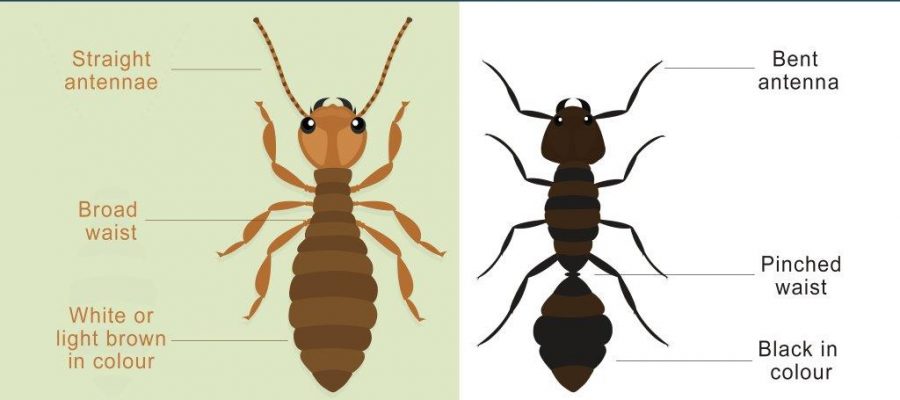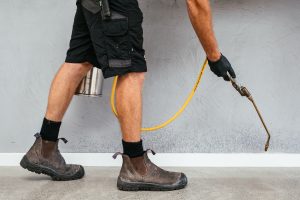How To Identify Termites?
- June 10, 2019
- in Pest Control
- by Ashley Dando
- 412
- 0

The termites are silent pests that like to eat in silence, but which can be very destructive if not treated. It is estimated that they are causing economical damage worth of billions of dollars worldwide, and worth of 100 million dollars in Australia. They can multiply very quickly and can eat anything that contains cellulose. If not stopped in time they can cause serious structural damage to your home, so it is important to recognize them from the first signs and to call a professional company right away. In this article, we’ll find out how to identify termites.
Termites are very similar to ants, and that’s why many people are confusing them. Since they are silent and prefer to stay hidden, you are more likely to see signs of termites instead of seeing the actual insects. There are also multiple species, and it’s important to identify their type in order to apply the right treatment. Termites are small insects with a straight waist, straight antennae and usually a white or translucid colour.
The ones who get confused the most are the swarming termites and the flying ants. Here are the main differences between the two, so you know how to identify termites:
– The waist of the termites is straight, while that of ants is pinched
– The antennas of termites are also straight, while those of ants are bent
– The four wings of termites all have the same length, while those of ants have different lengths. Also, flying ants do not shed their wings, while termites do. So if you find any wings somewhere in your home, then it’s a bad sign: it means that termites just established a nest somewhere on your property
Even if knowing all of these differences, it’s still hard to correctly identify them, as they are really small creatures. That’s why it is recommended to ask for the help of a specialised pest control company.
Regardless of the species of termites, there are 4 distinctive categories in a colony:
– The Alates – these are the termites with wings, and they swarm out of the nest in order to establish new colonies. Males and females pair up and search for a good place to lay a nest
– The King and the Queen – after the two alates find a good place, they shed their wings and start to reproduce. Their main goal is to create as many termites as possible in order to expand the colony. The nest is built around the termite queen, and then she is not able to move anymore. Her body develops in such a way to lay as many eggs as possible. A queen can lay up to 30,000 eggs each day, which results into 10 million per year. They take care of their babies until they are able to become a part of the colony
– The Termite Soldiers – their role is to defend the colony against enemies such as ants. They have bigger jaws and can produce sticky fluids or chemical sprays to attack enemies
– The Termite Workers – they are the bigger part of the colony and they do all the work. This includes feeding, grooming, making tunnels, eliminating the faeces and so on. They are the ones who are causing damage to people’s homes
Regardless of the species, all termites can cause damage to your property. It is the duty of the pest control workers to know the differences between various species and to apply the right treatment accordingly. Although it won’t hurt for a regular homeowner to know the differences as well, and to be aware of which termites are attacking their home.
There are thousands of species of termites all over the world, and around 300 found in Australia. But the most common types are:
They are the most destructive ones and the most common in people’s homes. They prefer wood that is already rotting and usually feed on fallen trees, stumps or fallen branches. But they can also feed with regular wood that is not rotten.
They need to have a source of moisture in order to survive, so they are building their nest close to the ground, so they can get the needed moisture from there. During dry seasons they go deeper into the ground in order to reach it.
They use soil and combine it with wood, faeces and saliva to create shelter tubes (also known as mud tubes). They are using these shelters to stay hidden and protected against enemies and to be able to travel and to eat silently. Of course, what they don’t know is that shelter tubes are one of the best indicators of termites, and you should call a specialist as soon as you notice one.
They can be exploratory tubes, working tubes, drop tubes or swarm tubes. Their activity is low during the winter or dry weather, and very high after heavy rain in the summer. But in tropical areas, they can be active most of the year.
Their colony is smaller (less than 1,000 insects) and can be fully found inside a piece of timber (unlike subterranean termites who spread over a larger surface). But there can also be multiple colonies inside a single piece of wood or furniture.
While subterranean termites follow the grain of timber, dry wood termites feed across annual rings and they usually avoid the heartwood. They feed on both soft and hardwood.
They also need some humidity to survive, but they get it from the wood and do not need to get in contact with the soil or sources of water. Since they only stay inside the wood and eat silently, they can thrive for many years without being detected, destroying that wood completely along the way.
Only the alates are leaving the nest, and they are only produced when the population of the colony is reduced to a critical point (this may take years if the colony is not detected). Then they fly away in order to establish a new colony.
They usually feed on wood that is very moist and decayed, and this is usually found outside (stumps, logs or trees). They create large galleries and they only stay inside of the infected wood.
Dampwood termites can also stay well-hidden and only be discovered when the wood is totally destroyed and when alates fly away in search of a new source of food and shelter. Their colonies are relatively small.
If you correctly identify damp wood termites in your home, it means that you have a moisture problem. If the source of moisture is removed, then the colony will soon die.
Most termites have sizes between ¼ and ½ of an inch (0.6 – 1.2 cm). They are quite small, yet they can be spotted by the human eye.
The working and the soldier termites live between 1 and 2 years, while the queen can survive for 25 to 50 years. The life cycle of a termite begins when the alates fly away in order to procreate.
After fertilization, the male and female alates shed their wings and become the king and the queen. They will be the centre of the nest and the ones responsible for reproduction.

After the queen lays the eggs, they hatch into white larvae which then moult into working termites, soldiers and reproductives. Their growth begins with the moulting process. First, a soft exoskeleton is formed under the current one. When the termite reaches maturity, the outer skeleton splits open, making way for the new one. This process can continue throughout the entire life of the insect.
We already presented the signs of termites in a previous article. Call us as soon as you notice any of them! Safeguard Pest Control is a family-owned and operated company that has been in business since 1989.
Our team of experts will arrive as soon as possible and will begin by inspecting the particularities of your own home. After finding the problem, we will come up with a custom action plan and we will get to work. We will accommodate your schedule and together we’ll find the right time to start the treatment.
Our treatments suit all types of homes and all budgets. Contact us today and let us help you get rid of termites! Call 07 5477 6675 or send us an e-mail at info@safeguardpestcontrol.com.au
Array